Mainichi Hanafuda: iris ribbon
 Here's another red banner without writing. Design-wise, I aim for simplicity with the junk cards and try to make them fairly similar. With the point cards like this one, I am starting to throw in some extra elements and mix it up a bit. I decided to include a couple of iris buds on this card to distinguish it from the others in the suit.
Here's another red banner without writing. Design-wise, I aim for simplicity with the junk cards and try to make them fairly similar. With the point cards like this one, I am starting to throw in some extra elements and mix it up a bit. I decided to include a couple of iris buds on this card to distinguish it from the others in the suit.
And that's it for irises. As I become more comfortable with the format, I am starting to branch out from the standard images on hanafuda cards and experiment with my own style. This is especially evident with the cards I working on for the next suit, which I will unveil tomorrow!

 Here we have the other half of the junk irises. Did you know that in Japan, irises are regarded as a symbol of success? I learned this from the description under a nice print of irises in my Hokusai book. In that same print, a grasshopper is walking down the leaf of an iris. Perhaps a grasshopper is the invisible animal in yesterday's card?
Here we have the other half of the junk irises. Did you know that in Japan, irises are regarded as a symbol of success? I learned this from the description under a nice print of irises in my Hokusai book. In that same print, a grasshopper is walking down the leaf of an iris. Perhaps a grasshopper is the invisible animal in yesterday's card?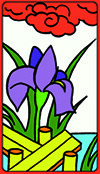 It's weird, but not all the "animal" cards in a hanafuda deck are actually illustrated with pictures of animals! The iris suit serves up the exception to the rule with this card. What we've got here is a dock or plank of some kind over water.
It's weird, but not all the "animal" cards in a hanafuda deck are actually illustrated with pictures of animals! The iris suit serves up the exception to the rule with this card. What we've got here is a dock or plank of some kind over water. All the previous suits have been 'flower cards,' of course, but they're not subjects I tend to think of as flowers: plum's a tree, grass is grass, and clover's more of a weed? Today we begin the iris, a suit that's identified clearly by its prominent flowers.
All the previous suits have been 'flower cards,' of course, but they're not subjects I tend to think of as flowers: plum's a tree, grass is grass, and clover's more of a weed? Today we begin the iris, a suit that's identified clearly by its prominent flowers. This clover card holds a banner like
This clover card holds a banner like  Like the nightingale for plum, the boar is an animal card in the clover suit. I was unhappy with my source images for boars until I found this
Like the nightingale for plum, the boar is an animal card in the clover suit. I was unhappy with my source images for boars until I found this  This is the second "junk" card in July's clover suit.
This is the second "junk" card in July's clover suit. Today, we move back one month to the July suit, clover. It's fun to draw branching geometric shapes! Originally, I thought the clover suit was one of the worst in the deck. It looked pretty boring. I dug through lots of photos of wild clover to see how I could embellish on the designs I found online, and finally ended up doing something that looks a lot like normal hanafuda cards anyway.
Today, we move back one month to the July suit, clover. It's fun to draw branching geometric shapes! Originally, I thought the clover suit was one of the worst in the deck. It looked pretty boring. I dug through lots of photos of wild clover to see how I could embellish on the designs I found online, and finally ended up doing something that looks a lot like normal hanafuda cards anyway. 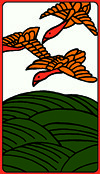 A flock, or three, geese fly over the hills of pampas grass. Geese were chosen to represent the August suit for Japan, but they would also be appropriate for a Minnesota hanafuda deck, if there was such a thing. Jenna and I spent last weekend in the country. As I was tending the fire, I heard for the first time this summer, some geese discussing a southern vacation. Soon they'll be honkin' all overhead until they've passed through here and arrived at Florida for the winter.
A flock, or three, geese fly over the hills of pampas grass. Geese were chosen to represent the August suit for Japan, but they would also be appropriate for a Minnesota hanafuda deck, if there was such a thing. Jenna and I spent last weekend in the country. As I was tending the fire, I heard for the first time this summer, some geese discussing a southern vacation. Soon they'll be honkin' all overhead until they've passed through here and arrived at Florida for the winter.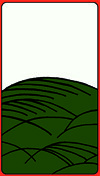 If the junk plum cards looked somewhat similar, then these pampas grass junks will look almost identical. But, examine them closely and you'll see that the lines are quite different. I hand-illustrated each individual card, even when I could've faked it and it would be purt near impossible to tell. That's just how I roll.
If the junk plum cards looked somewhat similar, then these pampas grass junks will look almost identical. But, examine them closely and you'll see that the lines are quite different. I hand-illustrated each individual card, even when I could've faked it and it would be purt near impossible to tell. That's just how I roll.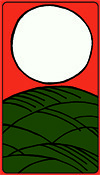 This is possibly my favorite card in the entire hanafuda deck, and one that's even more striking with a darker grass color. The "junk" cards in the pampas grass suit--like the one I displayed yesterday--are perhaps the least striking in the entire deck. But when the rounded hill of grass is contrasted with the bright full moon, it makes a striking image. This is one of two distinctive point cards in the suit, and a timely one, since August is the month represented here. (The full moon was on August 9th this year.)
This is possibly my favorite card in the entire hanafuda deck, and one that's even more striking with a darker grass color. The "junk" cards in the pampas grass suit--like the one I displayed yesterday--are perhaps the least striking in the entire deck. But when the rounded hill of grass is contrasted with the bright full moon, it makes a striking image. This is one of two distinctive point cards in the suit, and a timely one, since August is the month represented here. (The full moon was on August 9th this year.)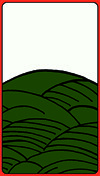 In the first four days of mainichi hanafuda, we looked at February's suit, which is plum. Everybody likes plum blossoms! But what's this thing supposed to be? Compared to the plum, it isn't pretty at all; it's just a hill of pampas grass, or eulalia. On most of the hanafuda decks I found online, this suit didn't even look like grass, it just looked like a big, round, black lump. And because this suit appears as an indistinguishable mound in most decks, Korean players have been known to refer to it as the "poop" suit.
In the first four days of mainichi hanafuda, we looked at February's suit, which is plum. Everybody likes plum blossoms! But what's this thing supposed to be? Compared to the plum, it isn't pretty at all; it's just a hill of pampas grass, or eulalia. On most of the hanafuda decks I found online, this suit didn't even look like grass, it just looked like a big, round, black lump. And because this suit appears as an indistinguishable mound in most decks, Korean players have been known to refer to it as the "poop" suit. Most sources I found identified the bird in this suit as a nightingale, although it was called something else in one place I looked. In Japan, the most common birds that I saw around plum trees were actually pigeons. But I used a nightingale for my photo reference on this card, so that's what I've got in my hanafuda deck.
Most sources I found identified the bird in this suit as a nightingale, although it was called something else in one place I looked. In Japan, the most common birds that I saw around plum trees were actually pigeons. But I used a nightingale for my photo reference on this card, so that's what I've got in my hanafuda deck.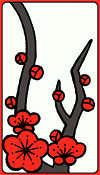 This is the other junk card from this suit. Notice how it's similar to yesterday's design, but a different pattern. You can also see a "full-on" blossom in this image. Variations on a theme are what make this type of work interesting; the changes in each card must be subtle enough that they can still be recognized as a piece of the whole suit. That's a particular challenge with hanafuda, since they don't use identifying numbers or symbols like a Western deck of playing cards. That's part of what appeals to me about the look of hanafuda. But, it makes hanafuda games a little trickier to learn, since first you have to learn what each of the cards mean!
This is the other junk card from this suit. Notice how it's similar to yesterday's design, but a different pattern. You can also see a "full-on" blossom in this image. Variations on a theme are what make this type of work interesting; the changes in each card must be subtle enough that they can still be recognized as a piece of the whole suit. That's a particular challenge with hanafuda, since they don't use identifying numbers or symbols like a Western deck of playing cards. That's part of what appeals to me about the look of hanafuda. But, it makes hanafuda games a little trickier to learn, since first you have to learn what each of the cards mean!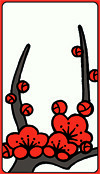 A standard Japanese hanafuda deck contains 12 suits of 4 cards each. Most of the suits contain 2 valuable cards that can be used to make high-point combinations, and 2 "junk" cards. Yesterday's red-banner card was special, and today's is one of the two junk cards in the plum suit. I enjoyed illustrating these plum trees, because it was one of the subjects I learned to paint during my Sumi-e class at Kansai Gaidai. Of course, it's a different technique and a much smaller scale, but I think they turned out very attractive all the same.
A standard Japanese hanafuda deck contains 12 suits of 4 cards each. Most of the suits contain 2 valuable cards that can be used to make high-point combinations, and 2 "junk" cards. Yesterday's red-banner card was special, and today's is one of the two junk cards in the plum suit. I enjoyed illustrating these plum trees, because it was one of the subjects I learned to paint during my Sumi-e class at Kansai Gaidai. Of course, it's a different technique and a much smaller scale, but I think they turned out very attractive all the same.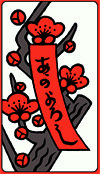 I've decided to take on the challenge of illustrating a full deck of Japanese
I've decided to take on the challenge of illustrating a full deck of Japanese 
